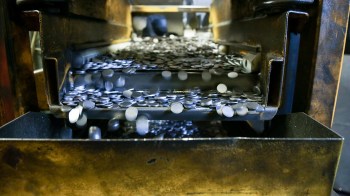Question: Someone in my family plans to invest $300,000 in silver and gold (mostly silver) because he read it’s the best place to make money in the next 5 years. Is that correct or is he going to ruin himself??? Please respond!!!! Jessi, Pembroke Pines, FL
Answer: My immediate response is to repeat the old — and wise — Wall Street warning: Caveat emptor. Or, buyer beware. Warning bells are going off.
Gold has been on a remarkable run. Prices have risen more than five times since 1999. The price of gold peaked at $1,900.23 last September. Gold is down by more than 12 percent since then. Silver peaked at $48.44 last April and has come down from that level by more than 26 percent. Precious metals like gold and silver are traditional hedges against economic turmoil and political chaos. Investors turned for refuge in gold (and to a lesser extent, silver) with all the upheavals of recent years, including wars, recession, housing bust, and concerns about too much government debt. The biggest driver has been Chinese, Indian and other emerging market savers seeking to get a better return on their money than what they can get by savings in government controlled markets.
I wrote about the factors behind the bull market in gold here. Bloomberg Businessweek has a fascinating story on the very different perspectives — one for and one against — on investing in gold from two investing titans.
Now, I am not a fan of gold. I agree with Buffett that it’s a fallow investment with no real intrinsic economic wealth. I would be concerned about putting money into precious metals after the long run up in prices. I could also be wrong about prospects for gold and silver. So, I want to put aside my thoughts about the market. It isn’t the right benchmark for answering your question.
Instead, there is a simple series of answers any experienced investor — including those trading precious metals — would give to your family member.
First, don’t risk your money if you don’t understand a market. It doesn’t matter if it’s gold, stocks or other assets. Knowledge and judgment about a market’s dynamics is critical before taking a cautious plunge.
Second, no one knows what the future will bring. No investor can pierce the uncertainty of the future. A forecast about gold being the best place over the next 5 years is nothing more than a prediction that may or may not come true. The past isn’t prologue when it comes to investing. I learned this early in my career working for Eliot Janeway. I edited his two investment newsletters in the early 1980s. A fascinating man, Janeway had created multiple careers as journalist, business consultant, columnist, investment advisor, newsletter writer and inveterate wheeler and dealer. He lived large. He was always deep in debt. He was very smart.
The late ’70s and early ’80s were scary. Inflation was high and rising. Interest rates were at double-digit levels. Oil and food prices were in the stratosphere. Janeway masterfully peddled doom and gloom all over the country, bellowing at people about the dire straits we were in — and what to do about it. Yet he had a genuine talent for spotting trends and going against consensus opinion. For instance, he was quick to sense that oil prices had peaked. He was early, too, in grasping that President Reagan’s policies would lead to far bigger budget deficits than most Wall Street analysts thought.
Here’s the thing: Janeway’s money counsel was eventually bad for his clients. He put them into gold in a big way. They did well at first, riding gold all the way up to a high of $850 a troy ounce in early 1980 (the equivalent of more than $2,200 in current dollars). But by 1982, the bull market in gold was over and it sank into a 20-year bear market. The bull market in stocks had begun, but Janeway was convinced the stock market rally wasn’t sustainable. He kept flogging gold, cajoling clients into sticking with the precious metal and disparaging stocks. Oops.
Third, veteran investors will always recommend speculating in a volatile market like gold and silver with only a sliver of your overall portfolio. The traditional European notion among the wealthy was to hold somewhere between 1 percent and 5 percent of assets in gold (diamonds, too). The gold investment wasn’t a speculation on rising prices, however. It was a long-term hedge against unexpected economic chaos and political upheaval. It was good news if the gold in their portfolio simply sat there doing nothing but drag down returns year after year.
Last, a theme of these posts is that understanding downside risk is key to managing money well. We can’t piece the investment fog of the future. There’s no certainty. With that in mind, I would run the numbers on this investment idea to figure out how serious would be the financial consequences to your family member’s cash flow and balance sheet — let alone dreams and goals — if it turns out the bet on precious metals goes really bad.
There’s a lot happening in the world. Through it all, Marketplace is here for you.
You rely on Marketplace to break down the world’s events and tell you how it affects you in a fact-based, approachable way. We rely on your financial support to keep making that possible.
Your donation today powers the independent journalism that you rely on. For just $5/month, you can help sustain Marketplace so we can keep reporting on the things that matter to you.


















